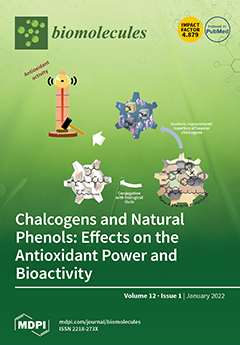Zrt2 is a zinc transporter of the ZIP family. It is predicted to be located in the plasma membrane and it is essential for
Candida albicans zinc uptake and growth at acidic pH. Zrt2 from
C. albicans is composed of 370 amino acids
[...] Read more.
Zrt2 is a zinc transporter of the ZIP family. It is predicted to be located in the plasma membrane and it is essential for
Candida albicans zinc uptake and growth at acidic pH. Zrt2 from
C. albicans is composed of 370 amino acids and contains eight putative transmembrane domains and an extra-membrane disordered loop, corresponding to the amino acid sequence 126–215. This protein region contains at least three possible metal binding motifs: HxHxHxxD (144–153), HxxHxxEHxD (181–193) and the Glu- and Asp- rich sequence DDEEEDxE (161–168). The corresponding model peptides, protected at their termini (Ac-GPHTHSHFGD-NH
2, Ac-DDEEEDLE-NH
2 and Ac-PSHFAHAQEHQDP-NH
2), have been investigated in order to elucidate the thermodynamic and coordination properties of their Zn
2+ and Cu
2+ complexes, with the further aim to identify the most effective metal binding site among the three fragments. Furthermore, we extended the investigation to the peptides Ac-GPHTHAHFGD-NH
2 and Ac-PAHFAHAQEHQDP-NH
2, where serine residues have been substituted by alanines in order to check if the presence of a serine residue may favor the displacement of amidic protons by Cu
2+. In the native Zrt2 protein, the Ac-GPHTHSHFGD-NH
2 region of the Zrt2 loop has the highest metal binding affinity, showing that three alternated histidines separated by only one residue (-HxHxH-) bind Zn
2+ and Cu
2+ more strongly than the region in which three histidines are separated by two and three His residues (-HxxHxxxH- in Ac-PSHFAHAQEHQDP-NH
2). All studied Zrt2 loop fragments have lower affinity towards Zn
2+ than the zinc(II) binding site on the Zrt1 transporter; also, all three Zrt2 regions bind Zn
2+ and Cu
2+ with comparable affinity below pH 5 and, therefore, may equally contribute to the metal acquisition under the most acidic conditions in which the Zrt2 transporter is expressed.
Full article






